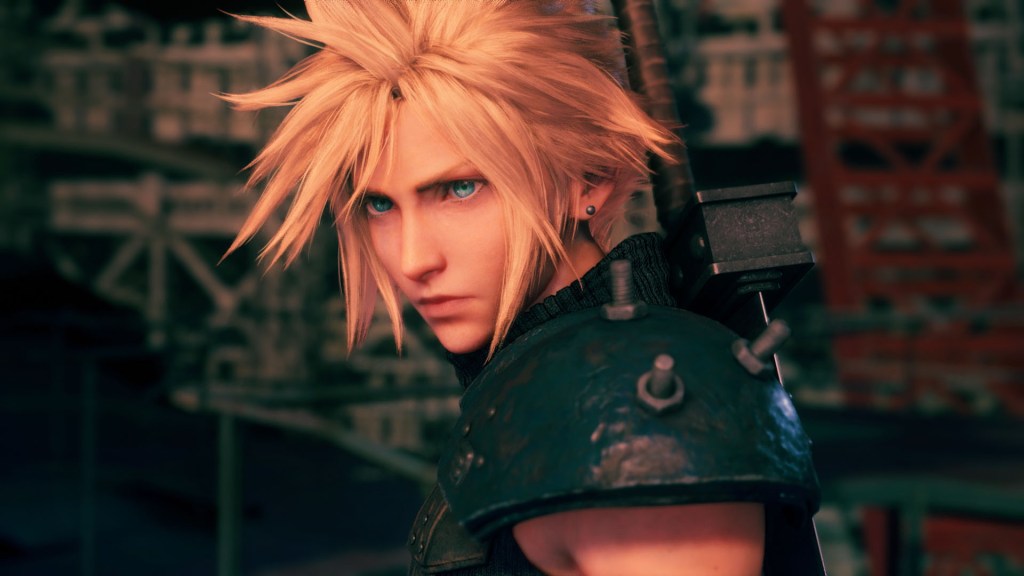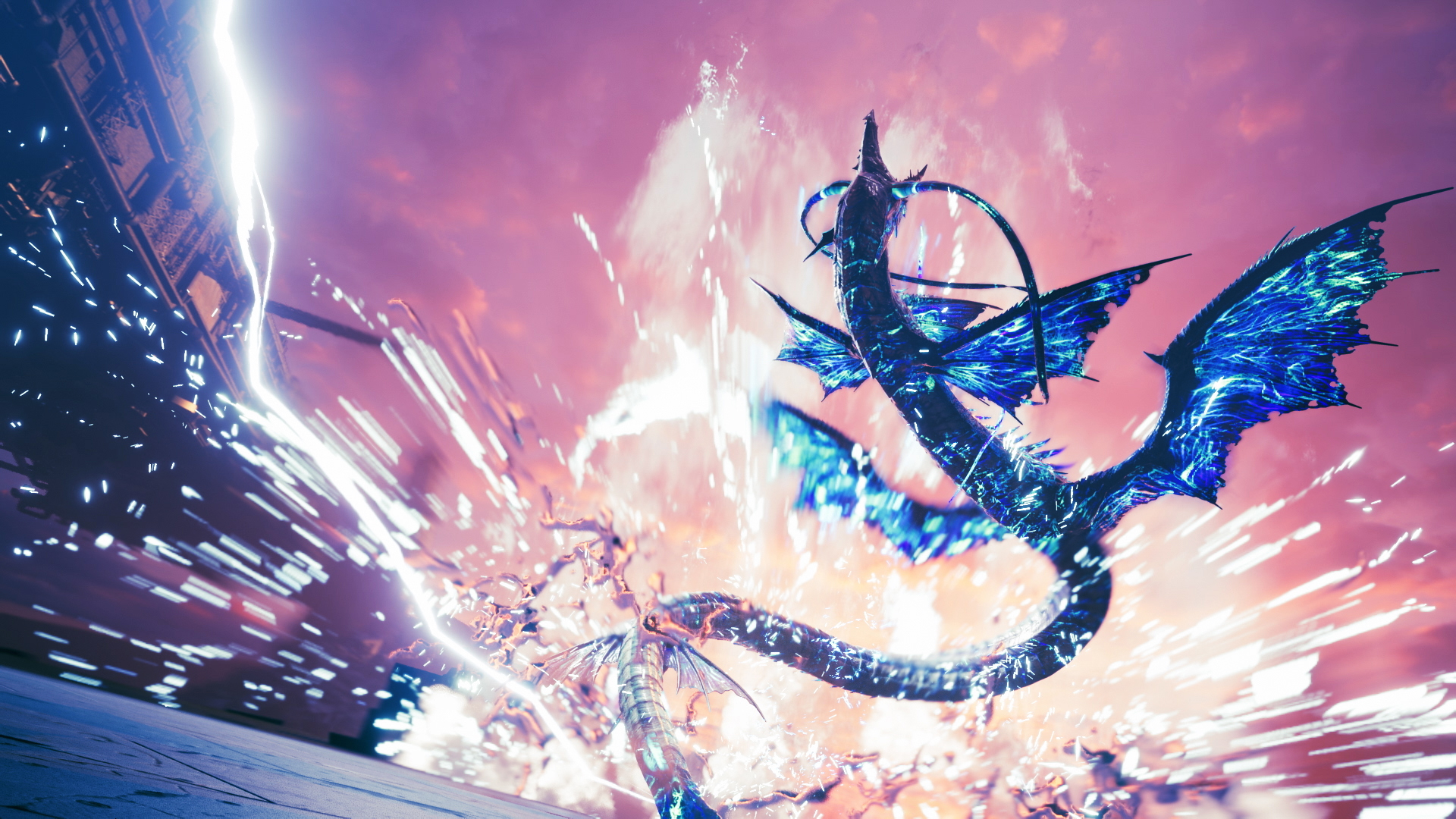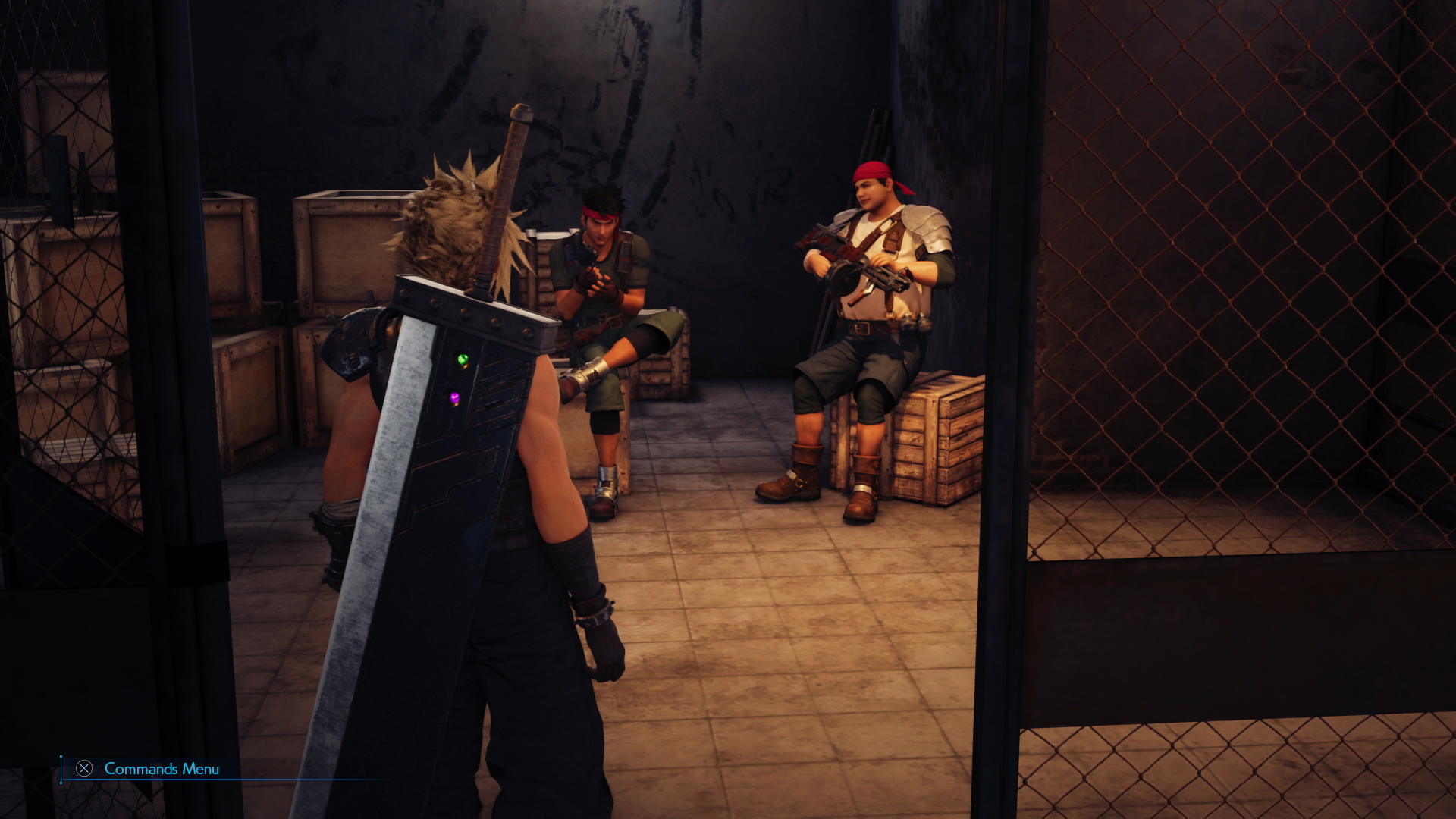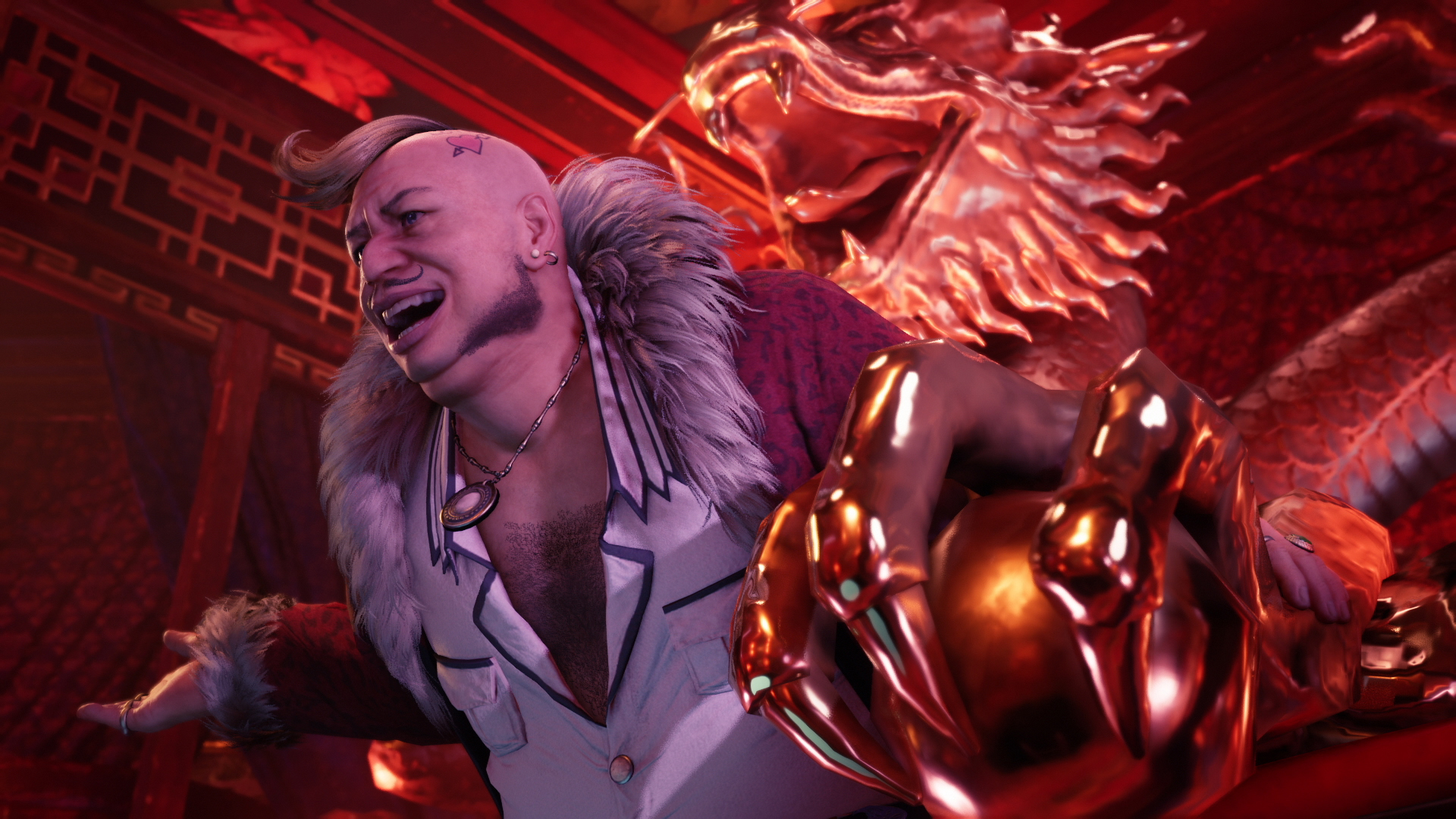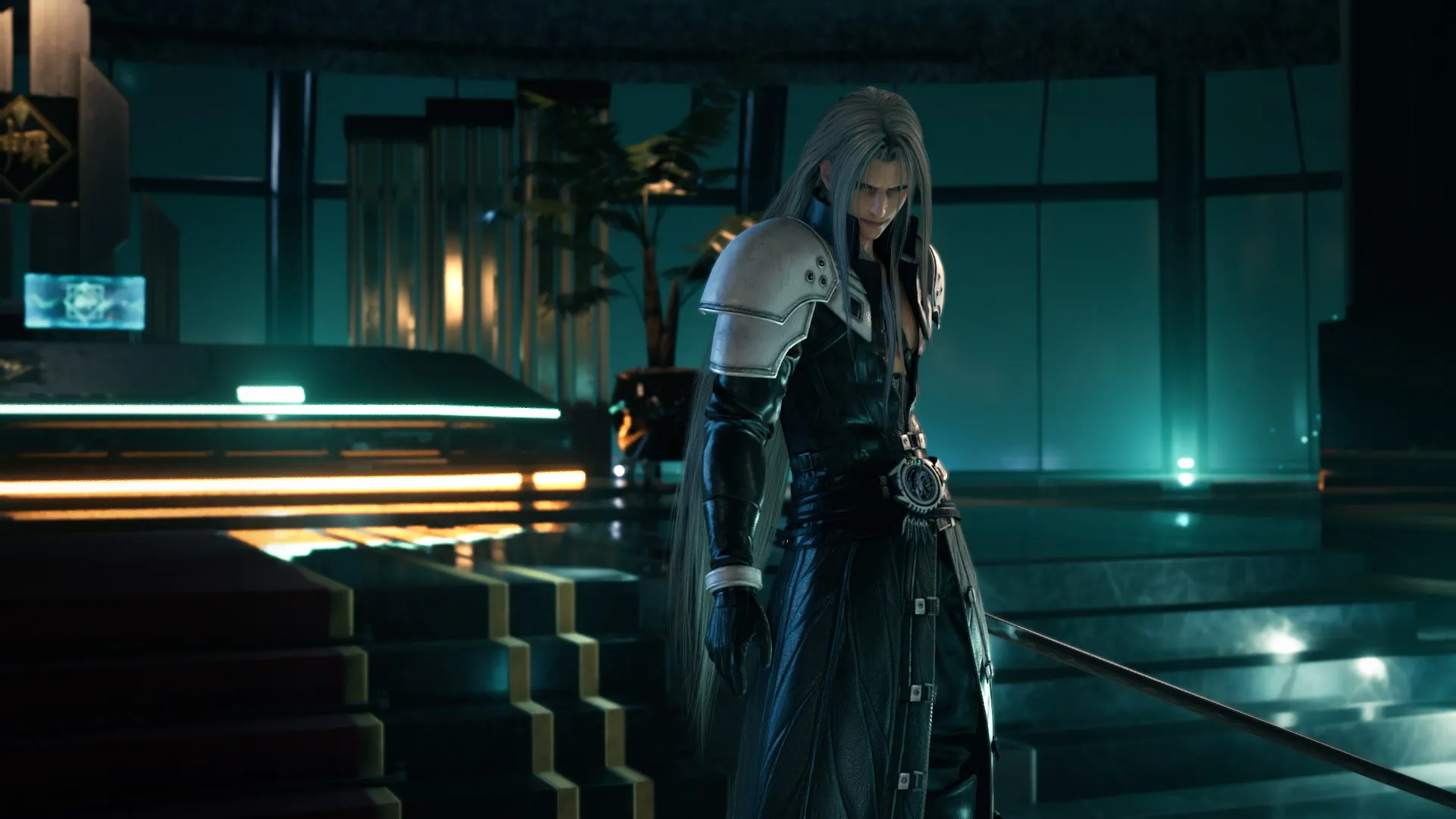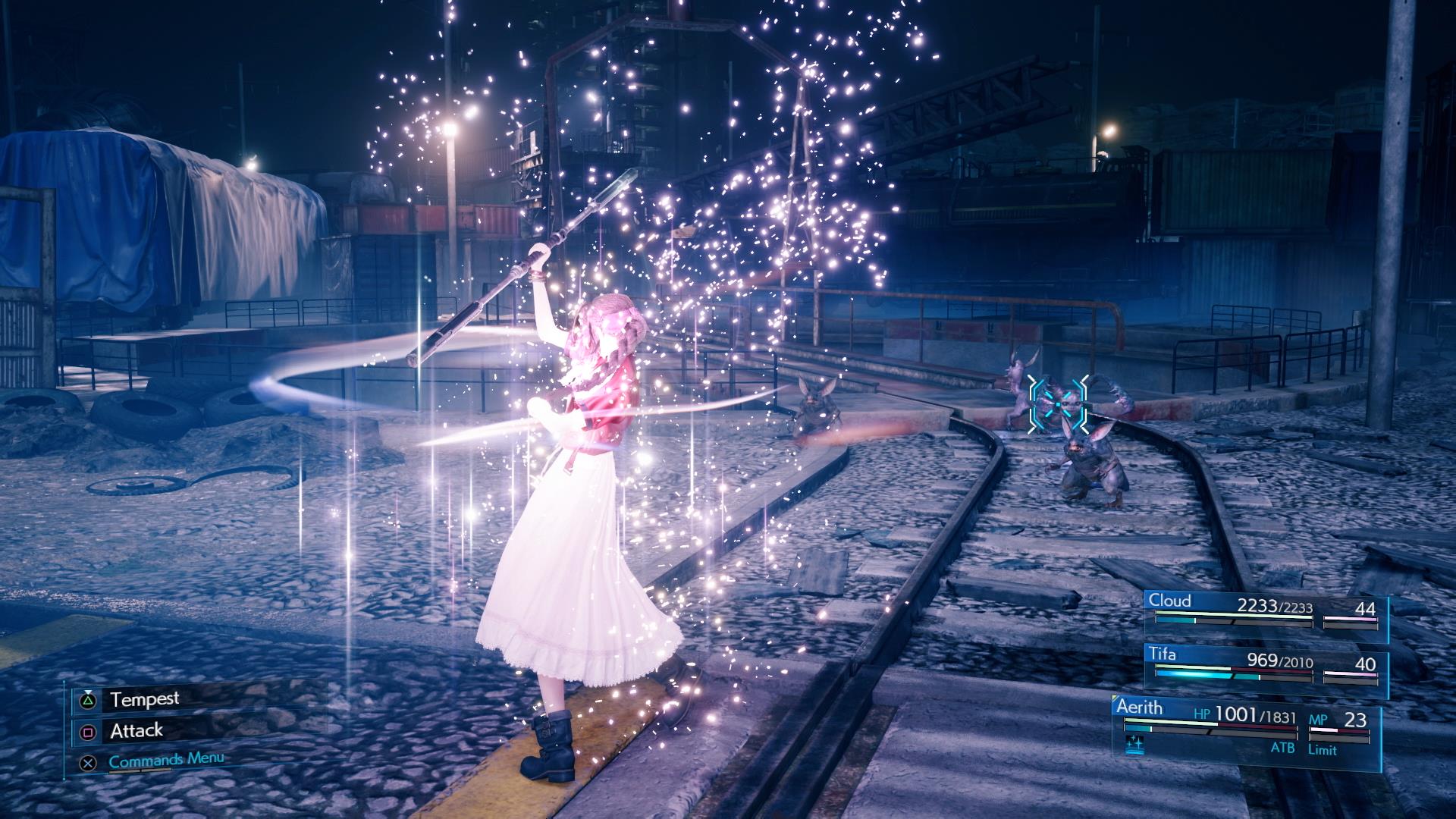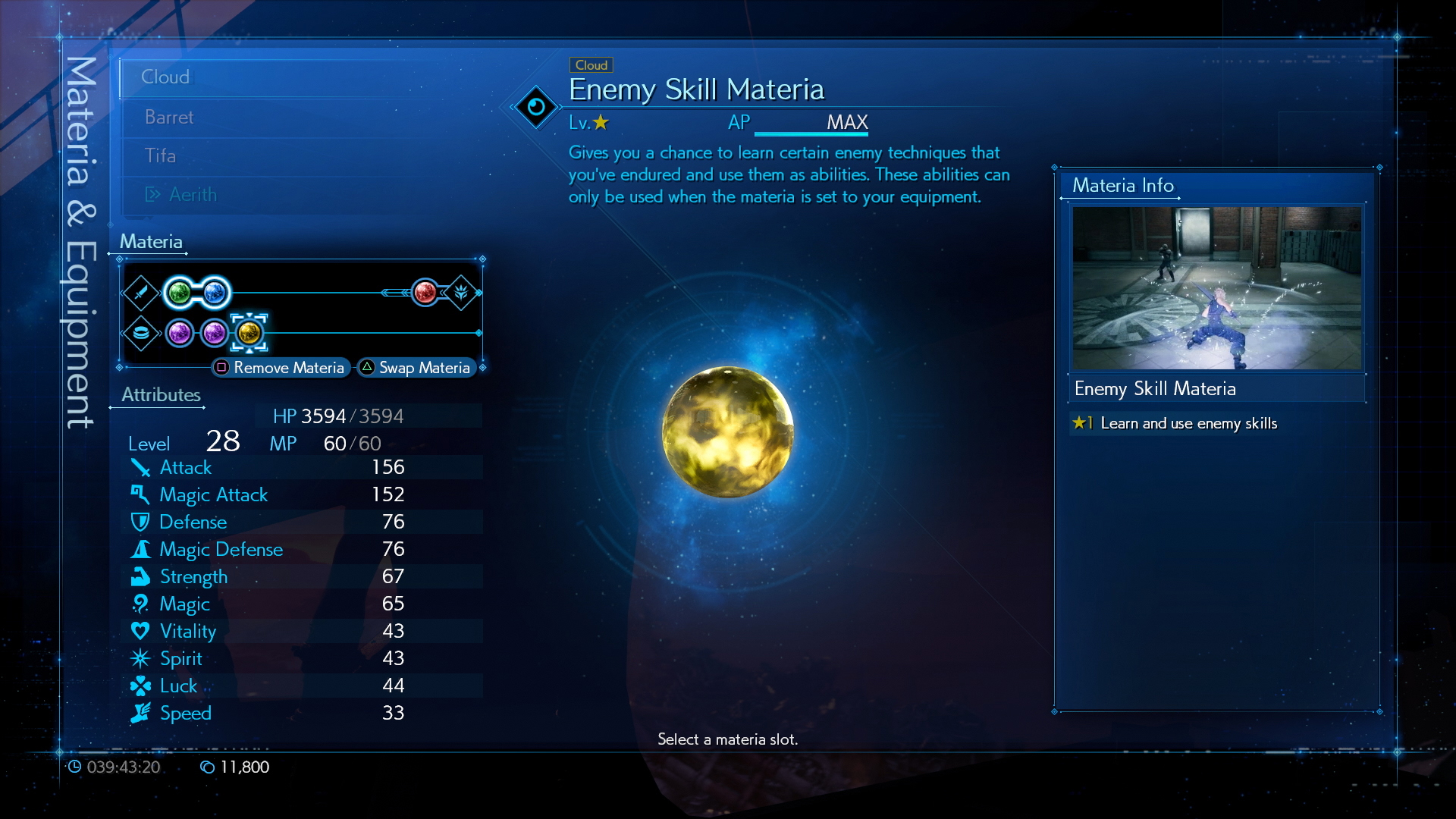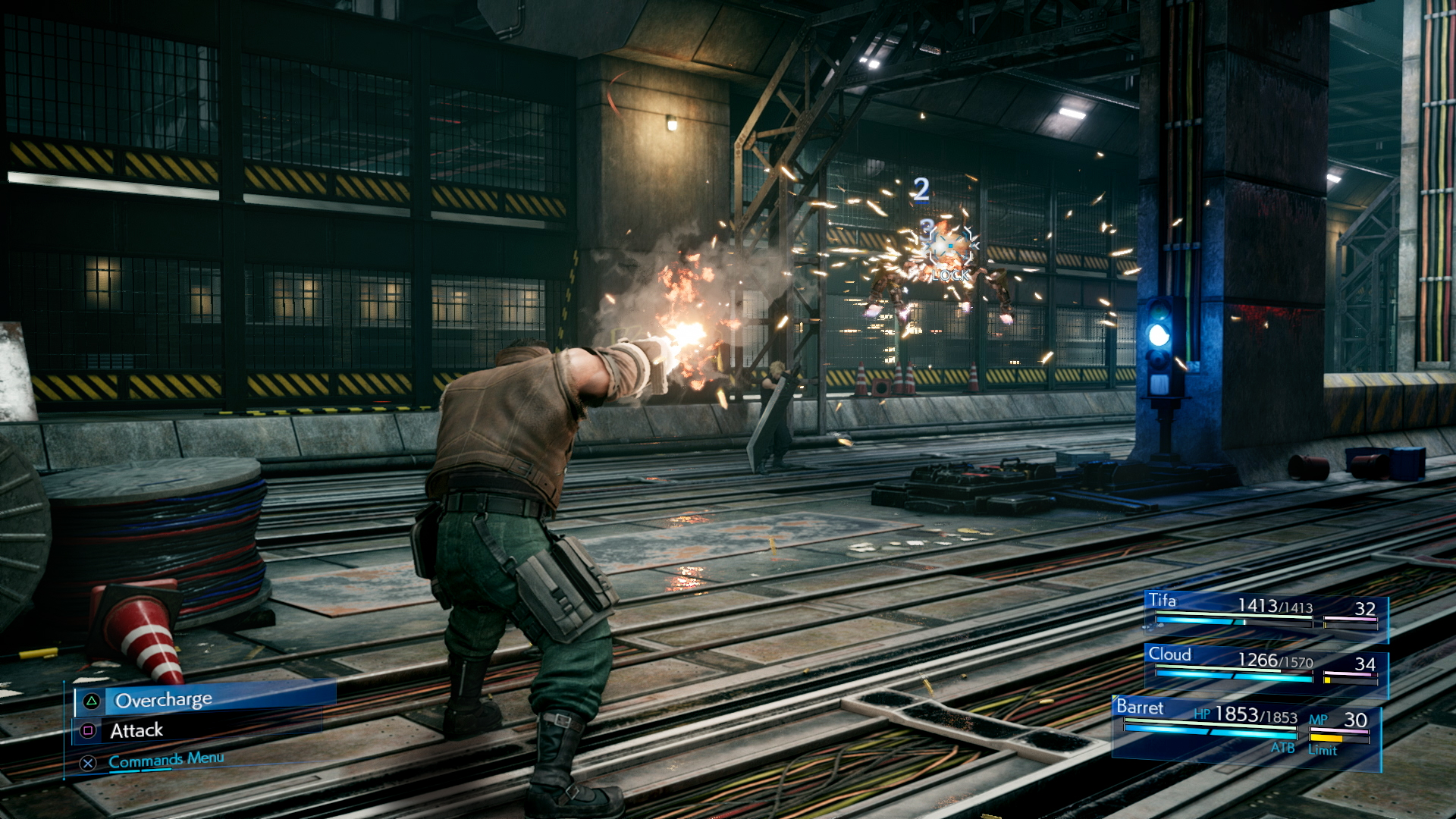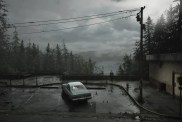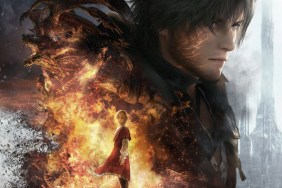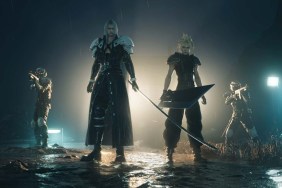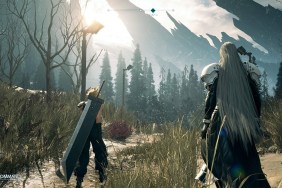For the PS5 version upgrades in Final Fantasy VII Remake Intergrade and the the Episode INTERmission DLC, read our separate review here.
Minor Spoiler Warning: It’s impossible to talk about Final Fantasy VII Remake without at least talking circles around certain things some may consider spoilers. I’ve made an effort not to spoil any direct major story beats or exactly where things happen—whether they are changed from the original game or still happen as you may remember. I do, however, talk generally about some themes and things that Final Fantasy VII Remake does that are important to the overall experience. If you want to go in completely blind, skip right to the score and know that the game is truly incredible in just about every way. To be honest, Square Enix has probably spoiled more in trailers for the game than I have here.
Released more than 23 years ago, Final Fantasy VII has persisted through the years as more than just that original PlayStation RPG. Through both video games and film, the Compilation of Final Fantasy VII has expanded on both the world and characters. Final Fantasy VII Remake returns to that original story, however, recreating and expanding on about the first 20% of the original game on modern consoles.
I’m an avid Final Fantasy VII fan. It was one of my first true loves of gaming. I’ve played through the original in some form or another no less than 10 times. I own multiple copies of the CG sequel film, Advent Children. I once spent tens of hours making a 1:6 scale papercraft model of Cloud. So while the idea of the remake was exciting to me, I also had high expectations. Final Fantasy VII Remake had to be more than just Cloud and gang in high definition, but couldn’t stray too far from the game I grew up with. Square Enix knew that, and it’s clear a lot of care went into balancing nostalgia for the original and making the remake feel like a new game and not just retreading old ground.
My first concern was Midgar not feeling like a “complete” story, and of course, by the end of Final Fantasy VII Remake, the rest of the journey has yet to unfold. But Square Enix managed to create a compelling narrative arc to the Midgar chapter, bringing life to Avalanche’s conflict with Shinra, the lives of people in the slums, and Cloud’s relationships with the characters around him. Moments, places, and people from the original are brought to life with a surprising amount of detail and accuracy, while new and expanded elements are pieced in, feeling completely natural even if you know where the gaps should be.
An impressive number of elements are faithfully recreated in all of their absurdity, yet still feel at home here. Cloud dresses up as a girl to sneak into Don Corneo’s mansion. The group journeys through the train graveyard. You’ll actually fight the Hell House at one point. I can’t count the number of times I verbally exclaimed “Oh wow! They actually DID that!” It’s amazing when almost nondescript environments and moments, like the collapsed expressway, are instantly recognizable here. Finally being able to say “Oh! THAT’S what they intended with that” leads to some incredible moments of clarity for a longtime fan.
Final Fantasy VII Remake Review – Bringing Midgar to Life
And still other things are completely new. In order to fill out Midgar and make it a complete game, the slums are brought to life with plenty of new characters, events, and places for Cloud, Tifa, Barret, and Aerith to visit. And it makes for a long game too. My final completion time ended up at just over 40 hours while taking in the sights and sounds that Midgar has to offer. Some replayability after completing the game could easily end up doubling that for players looking to do everything. If players want to speedrun the story, I’m sure they could come in well under that, but Final Fantasy VII Remake is still a 25-30+ hour game, minimum.
Best of all, none of it feels like “fluff” just for the sake of filling out Midgar. From the sidequests to the expansions and changes to the main story, there’s a natural fit for everything. While Midgar was an iconic location as a whole in the original game, it flew by rather quickly before players were unceremoniously dumped onto the world map outside its walls after just a few hours. And yet, with some of the very important events that happen here, setting up the entire rest of the game, expanding on this city of steel gives a much greater impact to everything. Final Fantasy VII Remake absolutely holds up as just being a game about Midgar.
And yes. You can expect to land most, if not all of the expected story beats, even if some of them come with a few little changes. The Reactor 5 mission goes down a little bit differently, but still includes the Air Buster boss battle (including creatively segmenting your party on two sides of the walkway, just like the original). Running up the stairs from the Don’s dungeon looks just like it did in 1997. And there’s absolutely the choice to either ride the elevator or take the stairs to the 59th floor of the Shinra building. There were so many things that immediately took me back because of just how accurately specific elements were recreated.
One treat of expanding on Midgar is allowing Jessie, Biggs, and Wedge the opportunity to have some meaningful character development instead of just being relegated to footnotes. Their personalities and interactions with each other and the main party are given the opportunity to stand out. But it’s not just them. The sliminess of Don Corneo comes through better than ever. The light-hearted and sarcastic innocence of Aerith is presented in a way we’ve never seen before. And the Shinra corporate structure is put into a new light that underlines just how far the company will go for its goals. It’s truly incredible what Square Enix was able to do when given the opportunity to give voice and detail to that which was once a bunch of voiceless polygons.
In fact, all of the characters have believability and emotion to them. Conversations feel natural and real. You get a natural sense for everyone’s motivations and how they feel about each other. Each character has a distinct personality and the way the characters and their relationships develop over the course of the game are made very clear through the amazing voice work. The friendship that blooms between Tifa and Aerith. Barret’s reluctant acceptance of Cloud. Cloud beginning to care more about the stakes at hand than just the money on the table. It’s all a joy to watch, made possible through beautiful facial animations and excellent voice acting.
The rest of Midgar is brought to life through voice as well. The slums are filled with chatter as people have conversations with each other about current events. I would stop periodically just to listen to what people had to say in order to expand my own understanding of this world. Unfortunately, the same great animation work given to the main characters doesn’t extend to many of the side NPCs who have really awkward and distracting mouth movements. It’s nothing that will impact the overall experience (the original game was all polygons, after all, and it was still amazing), but there’s a very noticeable discrepancy between the top-billed characters and the guy who wants you to clear a few drakes from a warehouse.
Final Fantasy VII Remake Review – Narrative Changes
Final Fantasy VII Remake focuses around the opening few hours of Final Fantasy VII. Cloud joins Avalanche as a hired merc helping to take down Shinra’s mako reactors that power and give life to Midgar. He stays involved because of a chance run-in with a mysterious flower girl and his past childhood friendship with Tifa, a member of Avalanche.
While most of Final Fantasy VII Remake is the Midgar storyline as you may remember, there are a few big narrative changes outside of the expanded elements. As I mentioned earlier, some of the circumstances surrounding the Reactor 5 mission are changed slightly. How you go about obtaining the items to dress up Cloud in Wall Market is a bit different. And your journey through Shinra HQ takes a very notable detour. The Midgar/Wutai war is also more talked about—which explains Midgar’s robust security force—and Shinra propaganda paints Avalanche as an ally of Wutai as a way of stoking fear against them, an element that wasn’t so explicitly present in the original.
But perhaps more than the changes to specific Midgar moments is the way that the wider Final Fantasy VII narrative is restructured to add Cloud’s past, Sephiroth, and other details you don’t learn about until much later in the original game. I mean, of course, they had to add Sephiroth to some extent. He’s the major villain for Final Fantasy VII, and in the original game, you only get hints of him before leaving Midgar.
In some ways, this adds some confusion and complexity that won’t be fully paid off until later games (assuming there will be more than one additional part of the Remake saga). While I was able to pick up on the cues and hints, knowing what’s coming, it might lack clarity for new players just experiencing Final Fantasy VII for the first time through the remake. Who is the weird guy staying in the apartment next to Cloud in the Sector 7 slums? What’s that memory of Tifa in the cowboy hat that Cloud keeps flashing back to? What was that other random thing that I’ll avoid spoiling but new players won’t have any idea what it means? What’s Wutai, and why is Midgar so afraid of them? There are a number of others, some key to plot moments too. If you’ve played Final Fantasy VII, you’ll know all of these references when they come up, but new players may just find them to be extremely random.
There’s also a major MacGuffin added to the remake that will undoubtedly be the biggest point of contention and conversation surrounding Final Fantasy VII Remake’s plot so far. I’ll avoid discussing it directly, as it ties into major story beats and some of the climactic moments of the game, but it could very well end up changing the entire theme and direction that the Final Fantasy VII Remake saga takes. After a lot of thought regarding this particular plot device (and some initial disappointment with it, admittedly), I’m willing to give it the benefit of the doubt for now. After all, this is just the first part.
The MacGuffin is a relatively late-game revelation, however, and while it’s woven throughout the story, it still doesn’t take away from the sheer awe of revisiting these iconic moments in Midgar. What all of these early shifts to the overall plot mean for the rest of the story is anyone’s guess, however. They are small changes, but the rippling effects could end up being enormous. With the level of care that was put into faithful renditions of key people, places, and events in Midgar, I can’t imagine Square Enix completely upending the rest of the game to the disappointment of fans. But you can bet that there will at least be very careful changes made moving forward.
Final Fantasy VII Remake Review – Active Turn-Based Combat
The world has shifted away from the slower pace of turn-based battle systems, yet turning Final Fantasy VII Remake into a full-on action game would have felt disingenuous to the original. Its battle system was such a core part of the game, that drastically altering it would have made the remake feel like another game entirely. What Square Enix came up with is the perfect blend of action and tactics, using an Active Time Battle (ATB) system that allows for turn-based elements while retaining fast-paced action reminiscent of the CG Advent Children sequel film.
As you fight, the ATB gauge will fill, giving you the opportunity to use special abilities, magic, or items. When you hop into the menu, the action slows to a crawl while you select the next thing you are going to do. Basic attacks don’t do a lot of damage, but they help fill the ATB gauge faster, which allows you to do the higher-damage abilities and spell. You can also switch between characters, either just issuing orders once their gauges are full or taking direct control of them.
And it still requires tactics too. You won’t be able to hack and slash your way through the game. Building out your party using equipment and materia is important to overcoming difficult foes. In fact, the materia system works pretty much identically to how it did in the original. By slotting different types of materia into your weapons and armor, you gain different abilities while leveling it up to be more powerful. Materia linking allows you to do things like add elemental damage to your attacks or gain additional defense against certain elements.
Later in the game, materia becomes about a lot more than just magic attacks, and new materia types actually play into the remake’s new battle system, including ones like Auto-Cure that let characters you aren’t controlling heal other characters automatically. I found myself deftly maneuvering between controlling different characters and navigating menus to make the most of each battle situation. It’s a brilliant design and the most natural evolution of classic turn-based combat systems. As one of the most core components of the game, it was important that Square Enix get the battle system right, and they absolutely nailed it.
Final Fantasy VII Remake Review – The Music Makes It
Characters can ooze personality and environments can be recreated in stunning detail, but what tied everything together was arguably the music. Like everything else, Final Fantasy VII Remake uses the original game’s soundtrack as a base and then expands on it with beautiful new arrangements and orchestrations that maintain the DNA of the classic songs. So many moments are given life because of the music that accompanies each one, and for a longtime Final Fantasy VII fan, I’ve come to attach the music to specific moments. So when the same track plays as Cloud and the gang ride the train away from the Reactor 1 bombing, there’s a specific sense of nostalgia and memory associated with it.
Each part of Midgar is highlighted by its accompanying piece of music. Whether it’s Cloud’s fall into Aerith’s church, or knowing the Turks are around thanks to their theme. Perhaps it’s meeting Don Corneo or wandering the streets of Wall Market. Even the connecting pathways between populated areas of the slums have their own music that calls back to the original game. Boss battles, Shinra HQ, and the main theme; every piece of music has its place and helps remind you of those roots. Yet it’s also given its own identity through the new theme song, “Hollow,” which has a number of arrangements at certain places within the remake. As with all other added elements, this new track slots into the existing soundscape well, feeling like a natural fit amongst the classic tracks of yore. (“Hollow” actually uses elements inspired by certain note structures of other songs in the original game.)
After finishing the game—which again, for me, took just over 40 hours—you’ll unlock chapter select and hard mode, which works as a kind of flexible New Game+ system. Certain items and events are only available the second time around, and you can freely move between the 18 chapters while maintaining all of your experience and gear. You’re still limited to the characters available at any given time (so Aerith can’t take part in the Bombing Run mission, for example), but it’s a lot of fun to face the game’s challenges again with new tactics and strategies under your belt. Hard mode also restricts the player from using items, which makes creating tactical loadouts with gear and materia even more imperative (and there’s a Trophy for finishing all chapters on Hard, too). There are even a couple of secret bosses to take on. After all, it wouldn’t be Final Fantasy without them, right?
Final Fantasy VII Remake is perfection. It breathes life into the cold steel of Midgar, adding weight and dimension to that which was once simply an introduction to a more grand adventure. It’s filled to the brim with reverent fan service that respects the source material while occasionally taking leave to subvert expectations. Final Fantasy VII is one of the most defining games of all time, and Square Enix’s modern-gen treatment of Midgar lives up to the legacy of the original in every way imaginable. The worst part is leaving us off on the cliffhanger we all knew was coming, waiting for the rest of their journey, but as much effort as clearly went into Midgar alone, it’s bound to be worth the wait.
Final Fantasy VII Remake review code provided by publisher. Reviewed on a launch PS4. For more information, please read our Review Policy.
-
Perfect recreation and expansion of classic characters, places, and moments
-
Battle system is the perfect blend of tactics and action
-
Adds weight and emotion to Midgar in a way the original never did
-
Recaptures the heart of FFVII in a way only possible on current tech
-
The music ties everything together
-
Late-game MacGuffin woven into the narrative will no doubt create some contention
-
Unimportant NPC facial animations aren't great
